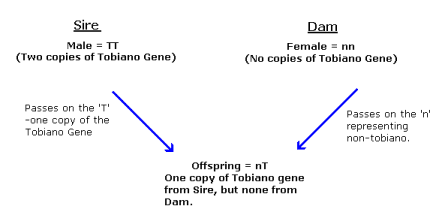WHAT IS A 'COLOURED' ANIMAL?
The definition of a “coloured” animal is black and white (piebald) or white and any other colour, e.g, bay, roan, chestnut grey (skewbald) with a patch of naturally occurring white coat. This white patch must be on the body above the level of the stifle or elbow, excluding face markings. Any white marking below this does not qualify. Manes and tails may also be white or have white in them.
Coloured horses and ponies.
Coloured horses and ponies, often referred to as Piebald, Skewbald, or Tri-coloured have long been amongst the most desirable of all equine specimens. Despite their rising popularity, little thought has been given to the genetics involved in creating their unique appearance. This article briefly explains the Tobiano gene and the testing available for this common coat colour pattern.
In the simplest terms, a foal randomly inherits half of its genetic makeup from the dam and half from the sire. The principles of how the Tobiano gene is passed from parent to offspring apply to any other gene or genetic trait.
* A horse that does not carry a Tobiano gene is Tobiano negative. In science, we give this a code and refer to a Tobiano negative simply as ‘nn’. A nn horse displays no Tobiano markings and will not pass the Tobiano gene on to its foals.
* A horse that carries a single Tobiano gene is referred to as ‘Tobiano heterozygous’ –the word heterozygous in reference to genes means ‘two different genes’. Tobiano heterozygous horses are referred to as ‘nT’. A nT horse displays Tobiano markings and will statistically pass the Tobiano gene on to 50% of its foals.
* A horse that carries TWO Tobiano genes is referred to as ‘Tobiano homozygous’ –the word homozygous in reference to genes means ‘two of the same’. Tobiano homozygous horses are referred to as ‘TT’. A TT horse not only displays Tobiano markings, but will pass the gene to 100% of its foals.
So, a Tobiano horse can carry either one or two Tobiano genes. The number of Tobiano genes the dam and sire carry will ultimately determine whether its offspring can potentially be heterozygous or homozygous for Tobiano.
The following points simplify how carrying one or two copies of a certain gene affect the inheritance of that gene to the offspring.
* The offspring inherits 50% of its genetic makeup from the dam and 50% from the sire.
* If a horse has two copies of a certain gene (homozygous), it is guaranteed to pass one copy on to its offspring.
* If a horse has one copy of a certain gene (heterozygous), it is 50/50 as to whether or not it will pass the gene on to its offspring.
Here is an example of the above points, using the Tobiano gene as mentioned before

The offspring in the chart above is heterozygous, 50% of the time it will pass on the Tobiano gene to its own offspring and 50% of the time it will not.
With some basic information of the Tobiano pattern and the genetics involved explained above, the following is a description of the possible results obtained via genetic testing:
* Tobiano Negative (nn): Solid, non-Tobiano horse.
* Tobiano Heterozygous (nT): Positive for the Tobiano gene and will produce both coloured foals and solid foals on a 50% likelihood basis for each.
* Tobiano Homozygous (TT): Will always produce coloured foals regardless of the mate.
By utilising Animal Genetics’ testing services, you have the ability to predict the ratio of Tobiano foals you can expect, as well as other equine genetic tests. Animal Genetics has developed a program to assist horse breeders in predicting possible offspring coat colours.
The ‘Coat Colour Calculator’ can be reached by following the link below:
http://animalgenetics.us/CCalculator1.asp
Or visit their UK DNA testing website by going to our LINKS page.
Close
Home Page